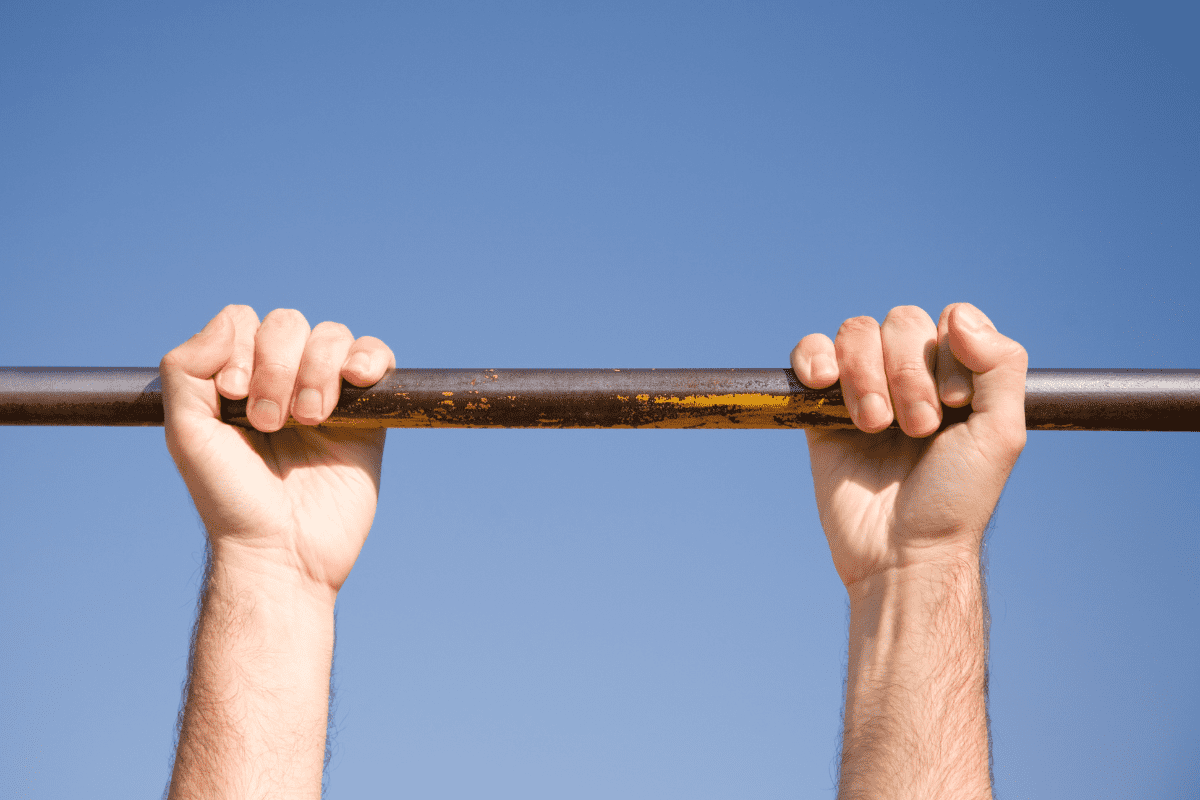What is a Supinated Grip?
You may have heard me mention a Supinated Grip on one of my how-to exercise descriptions. If you did and wondered what in the world is a “Supinated Grip”, then this article is for you!
I’m going to explain what a Supinated Grip is and how it differs from both a Pronated Grip and an Alternated Grip. I’m also going to explain in what situations and exercises you most likely want to utilize a Supinated Grip.
Let’s get right to it.
Supinated Grip Explained
Supinated is an anatomy term that relates to supination which according to Merriam-Webster is rotation of the forearm and hand so that the palm faces forward or upward and the radius lies parallel to the ulna.
So, if you hold your hands in front of you with your palms facing up – that is supination. To this day I still remember Supination as holding a bowl of soup, because that’s both what supination sounds like and what it looks like you’re doing when holding that position. Shout out to my high school anatomy teacher!
For our purposes in the weight room, a supinated grip almost exclusively means an underhand grip – gripping the bar with palms facing up.
Why Not Just Say Underhand Grip?
For the same reason sometimes I will call a Side Plank a Side Plank and sometimes I’ll call it a Lateral Plank. Or, why sometimes you may refer to your couch as the sofa or vice versa.
It’s a fair criticism to be sure and I do understand that it can cause some confusion. Strength Coaches and Trainers though are pretty awful at all getting on the same page when it comes to using common terminology. For instance, there are a few exercises that are called at least four different names that I’m aware of.
Supinated Grip vs Pronated Grip

If a Supinated Grip is an underhand grip, you can probably guess what a pronated grip is.
A pronated grip is when the hands are in pronation, or palms facing down. For all intents in purposes, this is what we would also refer to as an overhand grip in the weight room. A pronated grip is going to shift the emphasis of almost any rowing movement more to the upper back and away from the biceps and lower lats.
Supinated Grip vs Alternated Grip
An Alternated Grip (also referred to as a mixed grip) is when one hand is in supination (underhand) and one is in pronation (overhand). An alternated grip is helpful because the hand placement counterbalances the bar’s natural tendency to want to roll out of the hand. This provides a huge benefit to grip strength.
By far, the two most common exercises where you will use an alternated grip in the weight room are Deadlifts and Barbell Shrugs.
Benefits of a Supinated Grip
A supinated grip engages the biceps and lower lats more than a pronated grip generally does. By being able to incorporate more (and bigger) muscles into a movement the lifter is stronger in the movement and can move more weight.
So, if you’re looking to build absolute strength and you want to be able to go as heavy as possible, you’ll often find that using a supinated grip is the best grip to use.
Or, in the case of Chin-ups, most beginners will find Chin-ups easier than Pull-ups (more on these two exercises in a second). If this means that the lifter can perform reps and build confidence faster with a supinated grip then I’m all for it.
Common Exercises Using a Supinated Grip
When are you most likely to use a Supinated Grip in the weight room? Here are some of the most common exercises:
Chin-Ups

You may not even be aware of this but Pull-ups are technically only actually Pull-ups when used with a Pronated Grip. If you’re using an underhand, or Supinated Grip, you’re technically doing Chin-ups.
The differences between the two are not drastic, but Chin-Ups place a little more emphasis on the biceps whereas Pull-Ups put more emphasis on the back.
For the record, I like to use both in training programs.
Finally, if you are just getting to the point where you can do sets of 3 to 6 chin-ups at a time and you’re much better at Chin-ups than Pull-ups – then by all means continue doing Chin-ups! Don’t feel pressured into doing Pull-ups because it’s written on the sheet. This will only lead to unnecessary frustration. Keep rocking those Chin-ups and keep getting stronger!
Lat Pulldown
Lat Pulldowns are essentially the machine version of a Pull-up or Chin-up.
You can use a narrower, supinated grip to shift some of the emphasis onto the biceps or you can use a wider, pronated grip to really focus on the lats.
Inverted Rows & Barbell Rows
Inverted Rows and Barbell Rows are both common horizontal rowing exercises that can be done with both a Supinated and Pronated Grip.
I would usually allow my athletes to use whichever grip they were most comfortable with. Yes, there are slight differences in the muscles engaged between the two different grips but not nearly enough to worry about micro-managing in my opinion.
Pretty Much All Curls
Almost every curl exercise that you can do in a weight room is done with a supinated grip.
The first exception would be Hammer Curls which are done with a neutral grip. I haven’t mentioned neutral grip yet, but a neutral grip is when both palms are turned in to face one another. The other major exception would be Reverse Curls done with an overhand grip on the bar.
Final Thoughts
A Supinated Grip sounds overly technical, but it’s really not. Just remember that supinated means holding a bowl of soup and you’ll know that an underhand grip is needed for the exercise you’re learning about.

